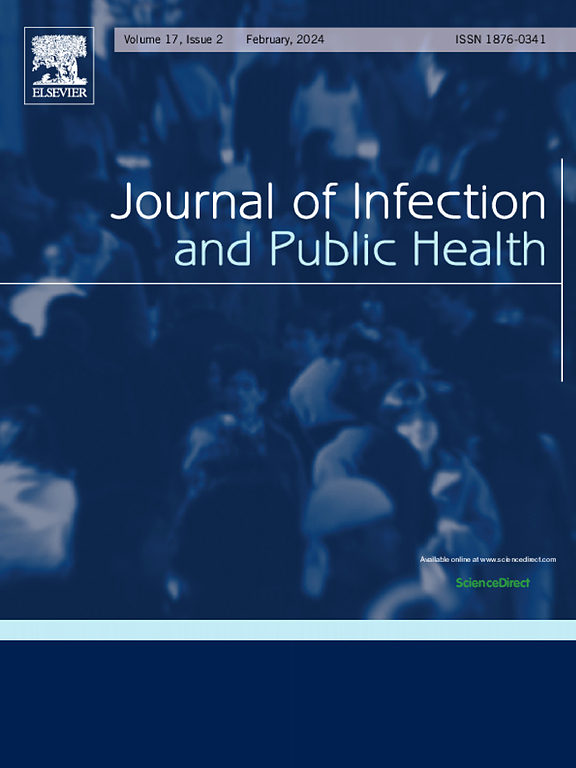In-house assays for detecting anti-SARS-CoV-2 antibodies in serum and urine: Correlation with COVID-19 severity from a cohort study in Qatar
IF 4.7
3区 医学
Q1 INFECTIOUS DISEASES
引用次数: 0
Abstract
Background
Serological assays targeting antibodies against key viral proteins, including the Spike (S1), Receptor Binding Domain (RBD), and Nucleocapsid, play a critical role in understanding immunity and supporting diagnostic efforts during COVID-19 pandemic, and afterward. This study aimed to develop and validate in-house assays for detecting anti-SARS-CoV-2 antibodies in serum and urine.
Methods
ELISA-based assay was developed to detect IgG and IgM antibodies against SARS-CoV-2. The assay was examined in serum and urine samples of two different cohort of patients affected by COVID-19 disease with different severity and compared to age and sex matched control group. Neutralizing antibody activity was evaluated using an RBD-ACE2 binding inhibition assay. Additionally, a Sengenics protein microarray platform was employed to assess epitope-specific antibody responses.
Results
The in-house ELISA assay reliably detected antibodies in both 163 serum and 64 urine samples compared to 50 serum samples from healthy control, with strong correlations observed between antibody levels in the two biofluids. Neutralizing antibody levels correlated positively with disease severity, highlighting their clinical relevance. The performance of the in-house assays was comparable to commercial kits, and the Sengenics microarray provided detailed insights into antibody profiles, identifying dominant epitopes within the Nucleocapsid core domain and RBD.
Conclusions
The developed in-house assay demonstrated robust performance and versatility, offering a cost-effective and scalable alternative to commercial kits. Their ability to detect antibodies in both serum and urine highlighted their potential as non-invasive diagnostic tools. These findings contribute to advancing sero-diagnostic capabilities, improving understanding of immune responses to SARS-CoV-2, and supporting global efforts to monitor and manage COVID-19 effectively.
检测血清和尿液中抗 SARS-CoV-2 抗体的内部测定:卡塔尔一项队列研究中 COVID-19 严重程度的相关性。
背景:针对关键病毒蛋白抗体的血清学检测,包括刺突(S1)、受体结合域(RBD)和核衣壳,在了解COVID-19大流行期间及之后的免疫和支持诊断工作方面发挥着关键作用。本研究旨在开发和验证检测血清和尿液中抗sars - cov -2抗体的内部分析方法。方法:建立elisa法检测SARS-CoV-2抗体IgG和IgM抗体。对两组不同严重程度的新冠肺炎患者的血清和尿液样本进行检测,并与年龄和性别匹配的对照组进行比较。使用RBD-ACE2结合抑制试验评估中和抗体活性。此外,Sengenics蛋白微阵列平台被用来评估表位特异性抗体反应。结果:在163份血清和64份尿液样本中,与50份健康对照的血清样本相比,内部ELISA检测可靠地检测到抗体,两种生物体液中的抗体水平之间存在很强的相关性。中和抗体水平与疾病严重程度呈正相关,突出了它们的临床相关性。内部检测的性能与商业试剂盒相当,Sengenics微阵列提供了抗体谱的详细信息,确定了核衣壳核心结构域和RBD内的显性表位。结论:开发的内部检测显示出强大的性能和通用性,为商业试剂盒提供了成本效益和可扩展的替代方案。它们在血清和尿液中检测抗体的能力突出了它们作为非侵入性诊断工具的潜力。这些发现有助于提高血清诊断能力,增进对SARS-CoV-2免疫反应的了解,并支持全球有效监测和管理COVID-19的努力。
本文章由计算机程序翻译,如有差异,请以英文原文为准。
求助全文
约1分钟内获得全文
求助全文
来源期刊

Journal of Infection and Public Health
PUBLIC, ENVIRONMENTAL & OCCUPATIONAL HEALTH -INFECTIOUS DISEASES
CiteScore
13.10
自引率
1.50%
发文量
203
审稿时长
96 days
期刊介绍:
The Journal of Infection and Public Health, first official journal of the Saudi Arabian Ministry of National Guard Health Affairs, King Saud Bin Abdulaziz University for Health Sciences and the Saudi Association for Public Health, aims to be the foremost scientific, peer-reviewed journal encompassing infection prevention and control, microbiology, infectious diseases, public health and the application of healthcare epidemiology to the evaluation of health outcomes. The point of view of the journal is that infection and public health are closely intertwined and that advances in one area will have positive consequences on the other.
The journal will be useful to all health professionals who are partners in the management of patients with communicable diseases, keeping them up to date. The journal is proud to have an international and diverse editorial board that will assist and facilitate the publication of articles that reflect a global view on infection control and public health, as well as emphasizing our focus on supporting the needs of public health practitioners.
It is our aim to improve healthcare by reducing risk of infection and related adverse outcomes by critical review, selection, and dissemination of new and relevant information in the field of infection control, public health and infectious diseases in all healthcare settings and the community.
 求助内容:
求助内容: 应助结果提醒方式:
应助结果提醒方式:


